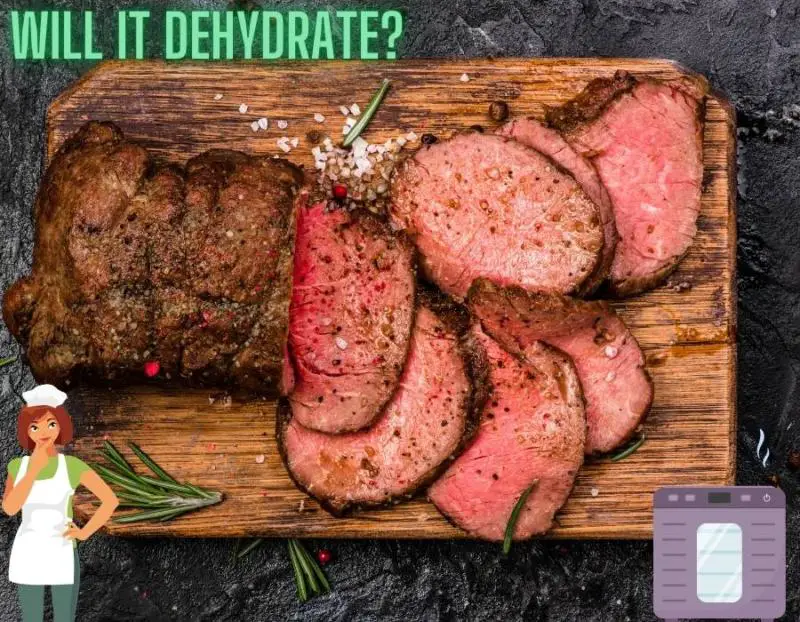Whether you are going hiking or just looking for a healthy treat, beef jerky is a great choice because it is portable, tastes great, and lasts long without refrigeration. Some hikers use it as a snack during the day while others combine it with vegetables and rice or pasta for a savory evening meal.
Yes, you can – and you should! Pre-cooked meat takes less time in the dehydrator, is safer and does give you the option of adding extra flavors and textures. Jerky can be made with both cooked and uncooked beef, but for poultry, it is always recommended to make jerky with cooked meat.
Beef jerky is also an easy way to pack protein on a hike, and its sodium content provides the electrolytes your body needs when you have a high water intake on a tough hike (although when you make jerky yourself, you decide how much sodium/salt to add). It is also a good source of protein, giving you a better recovery and quenching your hunger for longer.
The rest of this article is going to explain how you can make your own jerky and which dehydrator is the best for the purpose.
Can You Turn Roast Beef Into Jerky?
You can turn roast beef into jerky but it works better when it’s a roast dinner. With roast beef from a roast dinner rather than from deli meat, this will look more like jerky than the deli cold cut. In addition, you get to choose how to season and cook your beef before dehydrating it into jerky.

When you dehydrate deli roast beef, you can use the seasonings already present on the meat, to begin with. You could marinate it again to change the flavor if you so desire. One thing you must remember is that since it is thinly sliced and already cooked, you are very likely to get chips more than jerky because of the way deli meats are produced and roasted.
When using pre-sliced, pre-cooked roast beef from the grocery store, you can skip the marinating process and go straight to dehydrating. It usually takes only up to two hours for these thinly sliced meats to be dehydrated enough for consumption.
After dehydration, it can be stored for up to 6 months and rehydrated very well. It can be rehydrated in slightly salted water or beef stock for the best results.
So if you have some leftover roast from dinner or even a pack of deli meat you haven’t had the time to use, you can preserve it. While using roast beef from dinner, it will take a little longer to cook with all the juices from the initial cooking process of making your roast beef for dinner. You can dehydrate it and make some jerky or dried deli roast beef to preserve it for about 1-2 months.
Do You Have To Cook Meat Before Dehydrating or is Raw Meat Fine?
As a safety precaution, the USDA recommends you pre-cook your meat before you dehydrate it. This is to get rid of any micro-organisms in the meat itself that can be harmful for consumption.
However, jerky can be made without pre-cooking your meat since the dehydrating process will heat the meat and pre-cook it (and especially if you also plan to smoke it!).
To make poultry jerky safely it must be pre-treated with heat in the oven at 200 °F for at least 10min. – this is due to the risk of chicken and turkey being contaminated with certain bacteria such as salmonella and campylobacter.
If you choose to make your jerky directly from raw meat, make sure that your dehydrator can make it up to these temperatures long enough for the meat to be free of microorganisms.
Can You Leave Jerky In The Dehydrator For Too Long?
You can indeed over dehydrate your meat. Jerky is meant to be soft on the inside and when you over dehydrate it, it will become too crispy and hard. Over dehydrating can lessen the shelf life of your jerky so it’s not the best idea to keep your meat in your dehydrator for too long.
If your jerky is marinated for 6-8 hours as well as overnight, the jerky needs to dry out in the dehydrator for 4-15 hours depending on the type and pretreatment of the meat.
This is the maximum amount of time it takes to fully dry out your meat and successfully make jerky. Any longer and you will be over-cooking it.
If you do overcook your jerky, you can always rehydrate it in broth, water, wine, soup, or even bread. It will soften up and become chewy as it should be. Once rehydrated you can use it in any number of dishes such as salads and rice dishes for example.
However, making sure your jerky is dry enough is essential for the safety of the beef jerky.
What Is A Good, Cheap Dehydrator for Making Jerky?
If you’re planning to make a lot of beef jerky at home, the best dehydrator for this purpose is one that can handle the job without breaking your budget.
I recommend you can look for a model with an adjustable thermostat and a timer, however, if you’re on a very tight budget, the NESCO FD-37 is a good minimal option.
The best rated and most sturdy dehydrator with full functionality you can find on Amazon is the COSORI Premium Food Dehydrator. It comes with a nice metal finish and thick metal shelves that allow for the high temperatures needed for making every kind of jerky. It also has build-in light and a glass window so that you can follow your drying process at all times.
Another good and cheap dehydrator is the Hamilton Beach 32100C Digital Food Dehydrator. It comes with five trays and very good reviews on Amazon. It is one of the better bargain products out there that will do the job without a hassle. Along with jerky, the many trays can allow you to make lots of jerky at once or even use it to dehydrate fruit once in a while.
If you’re very passionate about jerky, then there are many upscale models ranging from the $200-$400 range which is just as worth it. The more expensive you go, the more capacity, so it really depends on how much you will be using your dehydrator for things other than meat to make jerky.
One of the top picks for the more ambitious chef is the highly popular Excalibur 9-tray version. It offers a huge capacity with room for almost two pounds of sliced jerky. A 360-degree air circulation system keeps the meat evenly dry. It has a drip pan and a fruit roll tray. Its digital control panel makes it easy to use and it is also quiet in use.
Conclusion
Jerky made from raw, marinated meat is cooked in the process of dehydrating, therefore cooked meat can be used to make jerky as well. Using cooked meat for dehydration can, however, allow you to be more creative with your cooking or use and preserve leftover meat that would otherwise go to waste.
Making jerky from roast beef is more effective with a cooked roast rather than deli-cut roast beef and you get to add your own flavors if you prepare it yourself.
Jerky is best made with a lean cut of meat with little to no fat on it. If there is fat, you need to cut it off or it will not turn out well in the dehydrator. Jerky can be made with any kind of meat, even fish, and can be marinated to your liking.







